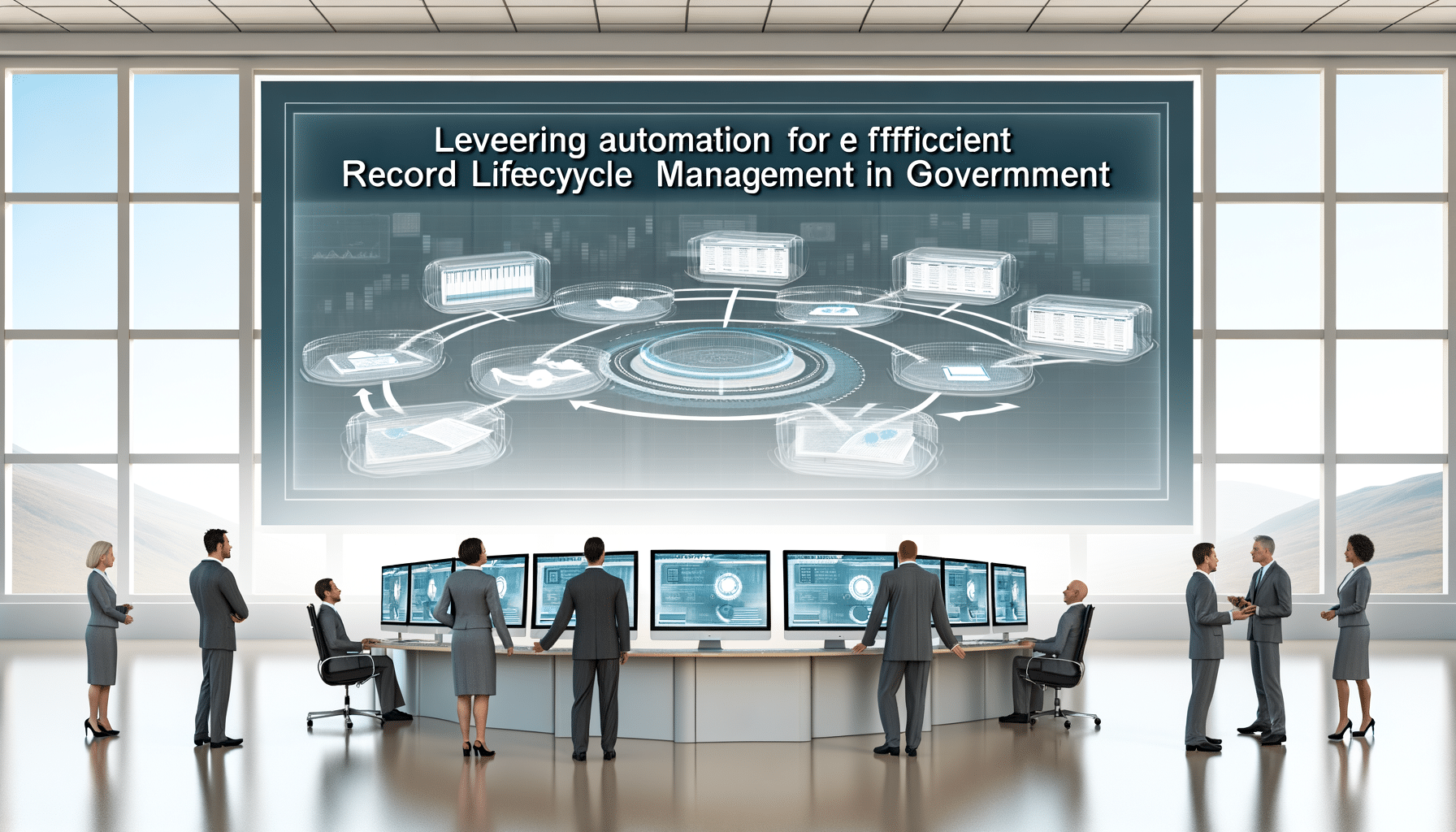- Automation Solutions
- May 29, 2024
Leveraging Automation for Efficient Record Lifecycle Management in Government

The ever-increasing volume of records in government departments puts immense pressure on traditional record-keeping methodologies. As I’ve encountered on numerous occasions, the operational inefficiencies that arise from manual processes can lead to delays, non-compliance issues, and even data breaches. That’s why embracing automation for record lifecycle management is not just beneficial—it’s essential for governments looking to streamline operations and enhance transparency.
Understanding the Record Lifecycle in Government
Before diving into the role of automation, it’s crucial to understand the typical stages involved in the record lifecycle within government settings:
- Creation/Receipt: The initial stage where records are created or received.
- Classification: Organizing records into categories for structured storage.
- Storage: The secure holding of records, compliant with regulatory standards.
- Access and Use: Authorized personnel leveraging records for informed decision-making.
- Maintenance: Keeping records up-to-date and archiving older files.
- Disposal: The lawful disposal or retention of records as prescribed by policy.
Automation can radically transform each of these stages, offering efficiencies that profoundly impact governance.
Creating and Receiving Records: The First Step to Automation
At the outset, automation equips government departments with the capability to automatically generate records from various digital sources. By doing so, consistency is maintained, and errors arising from manual entry can be minimized. Platforms like RecordsKeeper.AI offer seamless integration to capture crucial data and automate its entry into structured digital repositories.
Efficient Classification: Cutting Through the Clutter
One of the most time-consuming tasks—classification—benefits remarkably from AI-driven tools. Automated categorization enables the swift sorting of records into predefined pathways. This not only ensures files are easy to locate but also guarantees they are managed according to specific regulatory requirements. For example, leveraging keyword-based recognition or context analysis can reduce human error and enhance precision in classification.
Securing Storage Solutions with Automation
Governments handle highly sensitive information. Naturally, maintaining security in storage solutions is paramount. Automation combined with blockchain technology can ensure that data storage solutions are not only secure but also immutable. Implementing automated backup systems further ensures that records are never lost, offering an extra layer of confidence to government bodies grappling with data integrity concerns.
Facilitating Seamless Access and Use
Automated data retrieval systems powered by natural language queries reshape how records are accessed and used. Instead of drudging through countless files, personnel gain swift access to pertinent data points, facilitating decision-making processes. This augmented accessibility catalyzes informed governance, allowing government systems to function proactively rather than reactively.
Streamlined Maintenance of Records
With changing regulations and policies, keeping records up-to-date poses a significant challenge. Automation eases this task by updating records according to predefined rules or recognizing when a file requires archival. This ensures that all records maintained are legally compliant at all times, negating the risk of non-compliance penalties.
Ensuring Compliance in Disposal
At the end of a record’s lifecycle, compliant disposal is facilitated by automation protocols, enabling departments to follow precise, audited pathways to either archive or dispose of records appropriately. Automation ensures documents are not retained beyond their usefulness, aligning effortlessly with data retention regulations.
The Strategic Advantage of Automation in Government
Automation isn’t merely about replacing manual tasks—it’s about leveraging technology for a strategic advantage. By simplifying record lifecycle management, government departments can operate more efficiently and transparently. Given the sheer volume of data processed, automation ensures not only efficiency but also robustness against mistakes stemming from human oversight.
Final Thoughts
In closing, transitioning to an automated system for record lifecycle management poses both immense opportunities and necessary shifts in the operational narrative for government entities. As the founder of RecordsKeeper.AI, I’m excited to contribute these advancements, directly impacting efficiencies and compliance across the board. For government leaders and compliance managers, adopting automation holds the promise of better governance, reduced workload, and an enhanced capacity for strategic planning. Stay updated on our journey towards smarter solutions, and explore how else automation can transform everyday challenges into extraordinary achievements.
Toshendra Sharma is the visionary founder and CEO of RecordsKeeper.AI, spearheading the fusion of AI and blockchain to redefine enterprise record management. With a groundbreaking approach to solving complex business challenges, Toshendra combines deep expertise in blockchain and artificial intelligence with an acute understanding of enterprise compliance and security needs.
Related Posts

Automating Record Keeping Processes in Public Offices
Understand the role of automation in improving public office record keeping.
- May 9, 2024
Archives
- January 2025
- December 2024
- November 2024
- October 2024
- September 2024
- August 2024
- July 2024
- June 2024
- May 2024
- April 2024
- March 2024
- February 2024
- January 2024
- December 2023
- November 2023
- October 2023
- September 2023
- August 2023
- July 2023
- June 2023
- May 2023
- April 2023
- March 2023
- February 2023
- January 2023
- December 2022
- November 2022
- October 2022
- September 2022
Want to get more content like this?
Signup to directly get this type of content to your inbox!!
Latest Post
Document Control for Equipment Maintenance
- January 20, 2025
Managing Records for Multiple Clients
- January 19, 2025
Handling Conference Documentation
- January 18, 2025
Setting Up Department Record Reviews
- January 17, 2025





